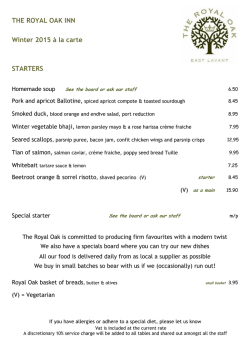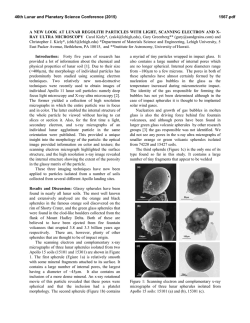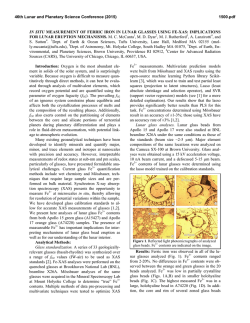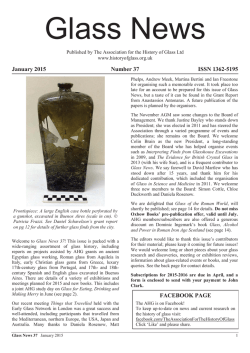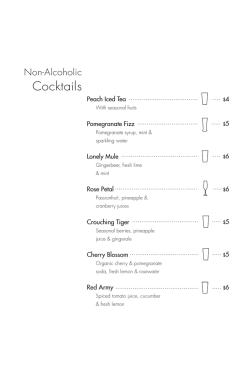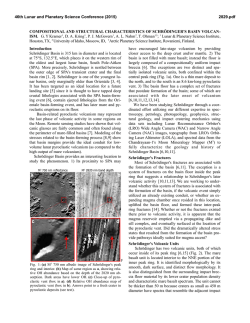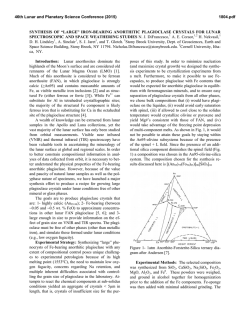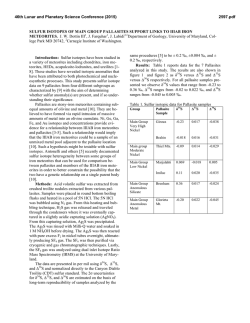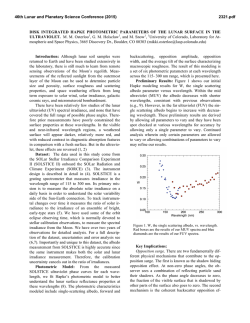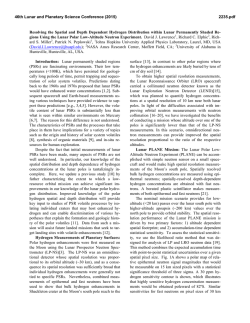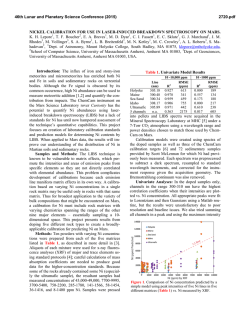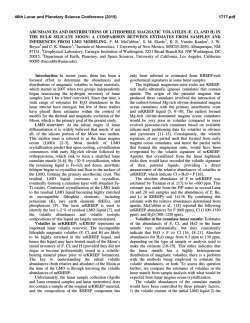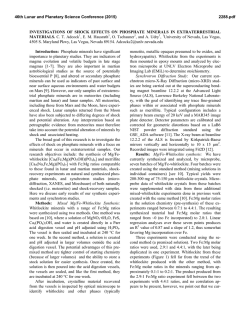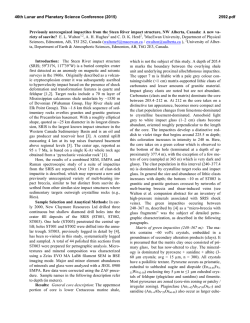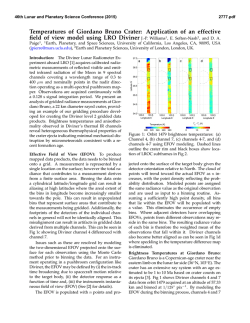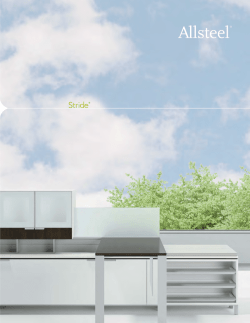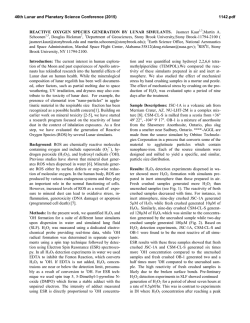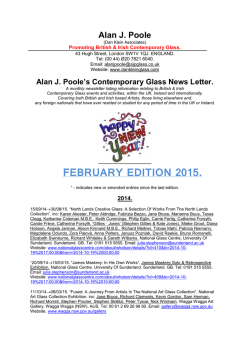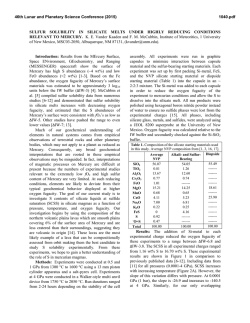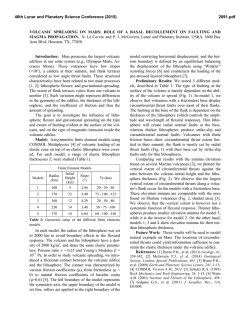
VOLATILE ABUNDANCES IN APOLLO 12 RED VOLCANIC GLASS
46th Lunar and Planetary Science Conference (2015) 2454.pdf VOLATILE ABUNDANCES IN APOLLO 12 RED VOLCANIC GLASS. E. H. Hauri1, A. E. Saal2, M. J. Rutherford2, J. A. Van Orman3, 1Department of Terrestrial Magnetism, Carnegie Institution of Washington, Washington, DC 20015, USA. 2Department of Earth, Environmental & Planetary Sciences, Brown University, Providence, RI USA, 02912 3Department of Earth, Environmental & Planetary Sciences, Case Western Reserve University, Cleveland, OH 44106 Introduction: Water plays a unique and important role in planetary origin and evolution, and the water content of a planet’s interior is one of the most important factors in determining the potential habitability of its near surface. Determining the abundance of water in planetary interiors is fraught with many challenges. Direct samples of planetary mantles are restricted to those from the Earth; for other planetary bodies we must rely on mantle-derived magmatic samples. The picritic volcanic glasses from the Moon are the most primitive mantle-derived samples known, having up to 19 wt% MgO in glass and having suffered the smallest extents of magmatic differentiation of any lunar samples [1]. Here we will report on the volatile content of volcanic glass from thin section 12033,581 containing the only known example of high-Ti red volcanic glass from the Apollo 12 site [2]. This glass represents an endmember of the chemical variability exhibited by the lunar volcanic glasses (LVGs), having the highest TiO2 (16 wt%) and FeO (24 wt%), the lowest SiO2 (34 wt%) and Al2O3 (4.5 wt%), and the highest amount of KREEP component [3]. This sample thus provides important constraints on the evolution of the lunar interior. Methods: The A12 red glass clod is a 1 x 2 mm grain that was originally cut into a single thin section (Apollo sample 12033,581) with no remaining offcuts; it thus represents the only known example of this chemical category of lunar volcanic glass. The thin section had been previously broken (without consequence to the A12 red glass clod) and reconstructed by attaching the fragments of the original glass disc onto a second 1-inch glass disc with epoxy. The thin section was coated with carbon for electron microbeam work. After microprobe work was completed, the thin section was lightly polished to clean the surface, then a small amount of indium was pressed into one large crack. Into this indium we pressed polished grains of synthetic forsterite and Suprasil quartz glass to serve as monitors of volatile detection limits. SEM & Electron Probe. We used the JEOL JSM6500F field-emission SEM at the Geophysical Laboratory, using a 1 nA beam @ 15 kV to obtain a detailed backscatter electron image at high spatial resolution. We then used the JEOL Superprobe at the Geophysical Laboratory to conduct high-precision major element analyses of over 350 grains within the A12 red glass clod, using a 30nA beam @ 15 kV to analyze Si, Ti, Al, Fe, Mn, Mg, Ca and Na. A15 green, A15 yellow, and A17 orange glasses previously analyzed by [1] and [4] were used as secondary standards and monitors of data accuracy. Data were averaged from 3-4 repeat analyses of individual glass fragments. SIMS. After removal of the carbon coat via polishing, we used the Cameca NanoSIMS 50L multicollector ion probe at the Department of Terrestrial Magnetism to measure C, H2O, F, S and Cl. A 10 nA primary beam was rastered over a 30 x 30 µm area for 60 seconds, and the area imaged to locate grain boundaries and cracks (which were numerous). For analysis the raster was reduced to 10 x 10 µm and beam blanking was enabled in order to count ions from the central 2 x 2 µm of the raster area. Detection limits were 0.13 ppm C, 1.53 ppm H2O, 0.68 ppm F, 0.04 ppm S (all measured on Suprasil) and 0.01 ppm Cl (measured on synthetic forsterite). These detection limits were considered satisfactory for conducting NanoSIMS analyses of the A12 red glass clod. Results: The A12 red glass clod consists mainly of crushed fragments of volcanic glass 5-30 µm in the longest dimension, with a subordinate number of whole beads up to 100 µm in diameter. All but the smallest whole beads, and many of the more numerous bead fragments, display cracks at the ~10-30µm scale. All glass fragments are variously devitrified, with submicron blades of olivine and ilmenite clearly identifiable in some bead fragments, barely discernable in others. The new high-precision major element data were conducted on fragments where the devitrification was least evident; the data show scatter outside of analytical reproducibility that is largely consistent with varying proportions of olivine and ilmenite under the electron beam. The glass appears to be homogeneous, and the average composition of the glass is very similar to previous work [2]. Thirty glass fragments were large enough for reliable NanoSIMS analysis. H2O varies from 3 to 33 ppm and is correlated with Cl, which varies from 0.08 to 1.61 ppm; F is present at 28-150 ppm while S varies from 600-1100 ppm. Carbon analyses were corrupted by the presence of surface contaminants from prior generations of carbon coat, producing apparent concentrations ranging from 0.1 to 100 ppm; this 46th Lunar and Planetary Science Conference (2015) carbon was unsystematic and not correlated with other volatiles, and was therefore considered compromised. Discussion: Volatile abundances of A15 green, A15 yellow, A17 orange and A12 red glasses all cluster into characteristic groupings with little overlap. The A12 red glass has a similar range of H2O as A15 green glasses [4,5], but for a given H2O content displays the highest F and S contents among these four groups. Sulfur is the most soluble of the volatiles that we have examined, and has the slowest diffusivity; the least-degassed S content from each group of LVGs correlates with its average FeO content, but this correlation is displaced to sulfur contents lower than an extension of the Fe-S correlation observed in terrestrial submarine volcanic glasses [e.g. 6] that is characteristic of sulfide saturation. Although each group of LVGs has undoubtedly degassed some sulfur during eruption, the extent of sulfur loss has not been so great as to erase the memory of pre-eruptive variations in sulfur content between the LVG groups. Indeed, diffusion modeling [5] and the comparison of glasses with melt inclusions [8] demonstrate that the highest S contents in each LVG group very likely approach the pre-eruptive magmatic S content. The correlation between the highest S in each LVG group and its FeO content is likely a manifestation of the primary variability of sulfur in LVG magmas that are undersaturated in sulfide, consistent with experimental results [7]. The highest S content in each group of lunar volcanic glasses is also inversely correlated with Mg#, and this indicates that the lunar magmas most enriched in ilmenite and KREEP components are also the most enriched in sulfur. This observation suggests that sulfur behaved as an incompatible element during fractionation of the lunar magma ocean (LMO), with low-Mg# residual liquids being enriched in sulfur and rare-earth elements (REE), and high-Mg# cumulates depleted in sulfur and REE. Fractionation of sulfide therefore was likely not an important process, and the inferred primary S contents are far below the sulfur contents at sulfide saturation in reduced magmas with similar FeO contents [7]. However, the S/Dy ratio decreases by a factor of three with decreasing Mg#, and this indicates that S did not perfectly track the REE during LMO fractionation. Although LMO models have yet to consider the varied controls on the sulfur content of ultramafic magmas, we suggest that the decrease in S/Dy with Mg# observed thus far in LVGs is a signature of LMO degassing. Among the other volatile elements that we have considered, F is highly soluble in silicate melts and is the next-slowest diffuser. Fluorine contents show a very good correlation with sulfur among the four 2454.pdf groups of LVGs measured thus far. Using the highest F contents in each of the LVG groups produces a F/S ratio that increases by a factor of four with decreasing Mg#, and F/Nd ratio that varies comparatively little (+/-30%), suggesting that F largely follows the REE and was not extensively degassed during LMO evolution. Based on the volatile content of volcanic glasses and vapor solubilities in reduced magmas [8], as well as a comparison of melt inclusions and glasses from A17 orange sample 74220 [4], we consider it likely that degassing of lunar magmas during eruption has occurred via two fundamentally different processes. The first phase of degassing involves pre-eruptive formation of a vapor phase, possibly under nearequilibrium conditions, that accompanies the magma during eruption and drives fountaining and magma fragmentation. The second phase of degassing involves diffusion-limited kinetic degassing from melt droplets after magma fragmentation. We consider it likely that the systematic differences of F and S among the LVGs reflect differences in pre-eruptive volatile contents, with the highest F and S in each LVG group only slightly modified by the first phase of degassing (preand syn-eruption). The range of F and S, as well as those of H2O and Cl, are an indication of the second phase of degassing (post-eruption). But neither of these degassing processes can explain the systematic shift of S/Dy, and relative constancy of F/Nd, with Mg# as we observe among the LVG groups. This volatile signature likely reflects shallow degassing of the LMO during formation of the lunar mantle. References: [1] Delano, J.W. (1986) JGR, 91 p. 201-213. [2] Marvin, U.B. and D. Walker, (1978) Am. Mineral., 63 p. 924-929. [3] Shearer, C.K. and J.J. Papike, (1993) GCA 57. p. 4785-4812. [4] Hauri, E.H., et al., (2015) EPSL 409 p. 252-264. [5] Saal, A.E., et al., (2008) Nature, 454 p. 192-196. [6] Wallace, P.J. and I.S.E. Carmichael, (1992) GCA 56. p. 1863-1874. [7]O’Neill, H.St.C. and J.J. Mavrogenes (2002) J. Petrology, 43 p. 1049-1087. [8] Rutherford, M.J. and P. Papale, (2009) Geology 37. p. 219-222.
© Copyright 2026
